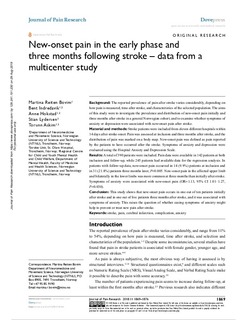| dc.contributor.author | Bovim, Martina Reiten | |
| dc.contributor.author | Indredavik, Bent | |
| dc.contributor.author | Hokstad, Anne | |
| dc.contributor.author | Lydersen, Stian | |
| dc.contributor.author | Askim, Torunn | |
| dc.date.accessioned | 2019-08-30T08:53:41Z | |
| dc.date.available | 2019-08-30T08:53:41Z | |
| dc.date.created | 2018-09-18T10:18:16Z | |
| dc.date.issued | 2018 | |
| dc.identifier.citation | Journal of Pain Research. 2018, 11 1869-1876. | nb_NO |
| dc.identifier.issn | 1178-7090 | |
| dc.identifier.uri | http://hdl.handle.net/11250/2611780 | |
| dc.description.abstract | Background:
The reported prevalence of pain after stroke varies considerably, depending on how pain is measured, time after stroke, and characteristics of the selected population. The aims of this study were to investigate the prevalence and distribution of new-onset pain initially and three months after stroke in a general Norwegian cohort, and to examine whether symptoms of anxiety or depression were associated with new-onset pain after stroke.
Material and methods:
Stroke patients were included from eleven different hospitals within 14 days after stroke onset. Pain was assessed at inclusion and three months after stroke, and the distribution of pain was marked on a body map. New-onset pain was defined as pain reported by the patients to have occurred after the stroke. Symptoms of anxiety and depression were evaluated using the Hospital Anxiety and Depression Scale.
Results: A total of 390 patients were included. Pain data were available in 142 patients at both inclusion and follow-up, while 245 patients had available data for the regression analysis. In patients with follow-up data, new-onset pain occurred in 14 (9.9%) patients at inclusion and in 31 (21.8%) patients three months later, P=0.005. New-onset pain in the affected upper limb and bilaterally in the lower limbs was more common at three months than initially after stroke. Symptoms of anxiety were associated with new-onset pain (OR=1.13, 95% CI 1.01–1.27, P=0.030).
Conclusion:
This study shows that new-onset pain occurs in one out of ten patients initially after stroke and in one out of five patients three months after stroke, and it was associated with symptoms of anxiety. This raises the question of whether easing symptoms of anxiety might help to prevent or treat new pain after stroke. | nb_NO |
| dc.language.iso | eng | nb_NO |
| dc.publisher | Dovepress | nb_NO |
| dc.rights | Navngivelse-Ikkekommersiell 4.0 Internasjonal | * |
| dc.rights.uri | http://creativecommons.org/licenses/by-nc/4.0/deed.no | * |
| dc.title | New-onset pain in the early phase and three months following stroke – data from a multicenter study | nb_NO |
| dc.type | Journal article | nb_NO |
| dc.type | Peer reviewed | nb_NO |
| dc.description.version | publishedVersion | nb_NO |
| dc.source.pagenumber | 1869-1876 | nb_NO |
| dc.source.volume | 11 | nb_NO |
| dc.source.journal | Journal of Pain Research | nb_NO |
| dc.identifier.doi | 10.2147/JPR.S165482 | |
| dc.identifier.cristin | 1610464 | |
| dc.description.localcode | Open Access. This work is published and licensed by Dove Medical Press Limited. The full terms of this license are available at https://www.dovepress.com/terms.php and incorporate the Creative Commons Attribution - Non Commercial (unported, v3.0) License. By accessing the work you hereby accept the Terms. Non-commercial uses of the work are permitted without any further permission from Dove Medical Press Limited, provided the work is properly attributed. For permission for commercial use of this work, please see paragraphs 4.2 and 5 of our Terms. | nb_NO |
| cristin.unitcode | 194,65,30,0 | |
| cristin.unitcode | 1920,15,0,0 | |
| cristin.unitcode | 194,65,35,5 | |
| cristin.unitname | Institutt for nevromedisin og bevegelsesvitenskap | |
| cristin.unitname | Medisinsk klinikk | |
| cristin.unitname | RKBU Midt-Norge - Regionalt kunnskapssenter for barn og unge - psykisk helse og barnevern | |
| cristin.ispublished | true | |
| cristin.fulltext | original | |
| cristin.qualitycode | 1 | |

